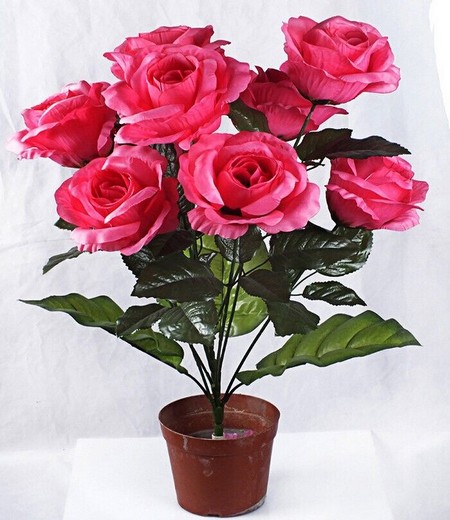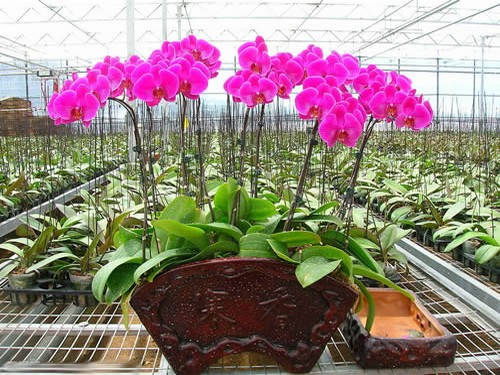How to raise potted Phalaenopsis
The butterfly orchid is graceful, and the flower is so named because it is shaped like a butterfly. It is widely planted all over the world. Phalaenopsis is a treasure of tropical orchids, which is deeply loved by gentle people. if you want to raise colorful Phalaenopsis, it is necessary to master the breeding methods and matters needing attention. The butterfly orchid is graceful and gorgeous in color, and has the reputation of "queen of orchid". How to raise Phalaenopsis with elegant colors? let's learn about Phalaenopsis breeding methods and matters needing attention.

Raise Phalaenopsis skills? If you want to raise colorful Phalaenopsis, it is necessary to master the skills of raising Phalaenopsis. The cultivation of Phalaenopsis needs to be carried out from the aspects of temperature, light, moisture, fertilization, changing pots and so on.
1. Temperature
Phalaenopsis is native to the tropics and likes the environment of high temperature and humidity. The suitable growth temperature is 16 ℃ to 30 ℃. During the growth period, the lowest temperature should be kept above 16 ℃, and the optimum temperature for growth should be 20-30%. When the growth is more than 35 ℃ in summer or less than 10 ℃ in winter, its growth will be inhibited. The blooming period is around the Spring Festival, proper cooling can prolong the viewing time, but not less than 13 ℃. When the summer temperature is too high, it is necessary to cool down and pay attention to ventilation. If the temperature is higher than 32 ℃, Phalaenopsis will usually enter a semi-dormant state to avoid continuous high temperature.
2. Lighting
Phalaenopsis does not need much light, which is about 1, 3, 3, 1 and 2 of the general orchid light, avoid strong light. If you put it on the indoor windowsill, cover part of the sun with a window screen, 80% in summer, 60% in autumn, and 40% in winter. Before and after the flowering period, proper light can promote Phalaenopsis to bloom and make the flowers gorgeous and lasting.
3. Moisture
Phalaenopsis is mostly born on tree trunks in the country of origin, the roots are exposed to the air, can absorb water from the moist air, and the air humidity should be kept at 70%. When artificial cultivation, the root is buried in the cultivation substrate, such as too much watering, the ventilation of the substrate will become worse, the fleshy root will rot, the leaves will turn yellow, fall off, and lead to death in serious cases. The principle of watering: see dry and wet, water thoroughly. When the indoor air is dry, you can use a sprayer or can to spray to the leaves, but it should be noted that the water mist should not be sprayed on the flowers during the flowering period to avoid falling flowers and buds.
4. Fertilization
In order to cultivate Phalaenopsis, aquatic plants and moss are generally selected as the cultivation substrate. The principle of fertilization should be less fertilization and light fertilizer. In the normal growth period, 2000 times of orchid special fertilizer was applied to the root, once every 2-3 weeks according to the growth condition. The compound flower fertilizer 1000-2000 times of water-soluble high phosphorus and potassium fertilizer can be selected before flowering and sprayed once every 10 days. Stop applying fertilizer at flowering stage and in the season with lower temperature.
5. Change the basin
It takes about two years from seedling to flowering. Adult Phalaenopsis should change pots and plant materials after flowering every spring, otherwise it is easy to accumulate dirt and moss, plant materials are also easy to rot, breeding diseases and insect pests. For potted Phalaenopsis, it is appropriate to use porous and breathable plain burning pots. When planting, the planting material on the basin floor should account for at least 1x2 of the basin capacity, and part of the roots should be exposed on the basin surface. Do not bury them completely and deeply, otherwise they will hinder breathing and growth.
6. Ventilation
The normal growth of Phalaenopsis needs flowing fresh air, so domestic Phalaenopsis must be well ventilated, especially in the high humidity period in summer, it must be well ventilated to prevent heat, and at the same time avoid the infection of diseases and insect pests.
Note:
1. Watering too frequently: friends who cultivate Phalaenopsis are always worried about the lack of water, regardless of whether the cultivation medium is dry or not, watering every day, resulting in serious root rot.
2. The temperature is too low: usually the flowering plants of Phalaenopsis are on the market in early spring, and they are generally appreciated in the living room after buying them home. Although the daily temperature in these places is enough, the night temperature is a little too low. On the other hand, most of the professionally cultivated orchids are in well-equipped greenhouses, in contrast, the temperature and humidity at home are not enough, so the growth of the plant tends to weaken day by day. Therefore, sometimes, no matter how well maintained, orchids still do not blossom.
3. Excessive fertilization: apply fertilizer as soon as there is fertilizer, and do not pay attention to the concentration, thinking that if you apply fertilizer, you will grow faster. It should be noted that Phalaenopsis should be fertilized with thin fertilizer, a small amount of fertilizer for many times. Keep in mind that "replenishment" should not be excessive, or it will be counterproductive.
4. Small plants grow large pots: feel that using large pots can give Phalaenopsis a relaxed environment and sufficient materials. In fact, after using a large basin, the water plant is not easy to dry, it is important to know that Phalaenopsis likes ventilation, ventilation is comfortable.
5. Flower dry bag: today's Phalaenopsis is mostly driven by flowers. After leaving the base, it is easy to have a dry bag problem after the environment changes. At this time, do not think it is dry, do not water more, but increase indoor humidity and control the indoor temperature. The temperature should not be too high. Try to buy flowers with thick petals.
Time: 2019-06-01 Click:
- Prev

Cultivation methods and precautions of potted roses
Everyone knows that roses are a symbol of love, so there will be many people planting roses. Rose language in ancient Greek mythology, rose set love and beauty in one, both the incarnation of God, but also dissolved into the blood of love. It can be said that roses are the universal language used to express love all over the world. Every Valentine's Day
- Next

Conservation methods and pest control of family potted Phalaenopsis
Phalaenopsis is a famous species of cut flowers. Phalaenopsis is a single-stem epiphytic orchid with short stems, large leaves, one to several flower stems, arched and large flowers, so named because the flowers are similar to butterflies. With beautiful flowers and gorgeous colors, it is a treasure of tropical orchids and is known as the queen of orchids. The butterfly orchid is graceful and gets its name because it is shaped like a butterfly.
Related
- Fuxing push coffee new agricultural production and marketing class: lack of small-scale processing plants
- Jujube rice field leisure farm deep ploughing Yilan for five years to create a space for organic food and play
- Nongyu Farm-A trial of organic papaya for brave women with advanced technology
- Four points for attention in the prevention and control of diseases and insect pests of edible fungi
- How to add nutrient solution to Edible Fungi
- Is there any good way to control edible fungus mites?
- Open Inoculation Technology of Edible Fungi
- Is there any clever way to use fertilizer for edible fungus in winter?
- What agents are used to kill the pathogens of edible fungi in the mushroom shed?
- Rapid drying of Edible Fungi

